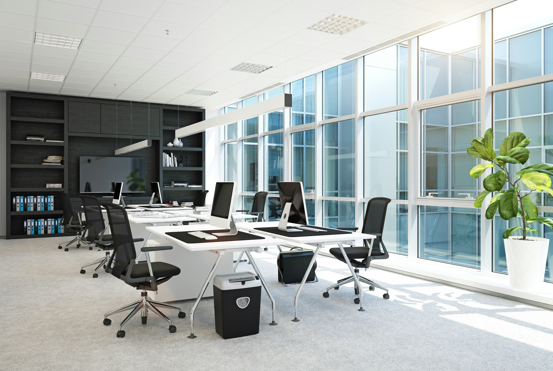
Lighting plays a crucial role in shaping workplace efficiency, employee well-being, and overall productivity. The right office lighting setup can reduce eye strain, minimize fatigue, and create an atmosphere that fosters focus and collaboration. With technology and design evolving, lighting trends are moving toward smarter, energy-efficient, and human-centric solutions. Let’s explore the latest lighting trends and how they can enhance workplace efficiency.
Human-Centric Lighting (HCL)
Human-centric lighting is designed to support the body’s natural circadian rhythm, helping employees stay alert during the day and wind down in the evening. By mimicking natural daylight, HCL enhances mood, boosts energy levels, and improves sleep quality. Many modern offices are incorporating tunable LED lights that shift from cool white light in the morning to warmer tones later in the day.
Benefits:
- Reduces fatigue and improves focus
- Enhances overall well-being and sleep quality
- Supports natural circadian rhythms
Smart Lighting Systems
Smart lighting systems use sensors and automation to adjust brightness and color temperature based on occupancy and natural light levels. These systems not only save energy but also create a more comfortable work environment by providing optimal lighting conditions throughout the day.
Features:
- Motion sensors for automatic on/off control
- Dimmable lighting based on daylight levels
- Customizable settings via smartphone apps or voice control
Energy-Efficient LED Lighting
LED lighting continues to dominate office spaces due to its longevity, energy efficiency, and cost savings. Modern LED fixtures use significantly less energy than traditional fluorescent bulbs while providing better quality lighting with adjustable color temperatures.
Advantages:
- Lower energy consumption and reduced utility costs
- Longer lifespan (up to 50,000 hours)
- Less heat emission, creating a cooler office environment
Task Lighting for Personalized Workspaces
Task lighting allows employees to customize their individual workstations with adjustable desk lamps or under-cabinet lighting. This reduces glare, eye strain, and headaches, especially in offices with open floor plans where general lighting may not be sufficient for every desk.
Why It Works:
- Provides direct illumination for focused tasks
- Reduces dependence on overhead lighting
- Enhances individual comfort and productivity
Biophilic Lighting Design
Biophilic design integrates natural elements into the office, including lighting that mimics daylight and enhances indoor greenery. Skylights, large windows, and light fixtures that resemble natural sunlight contribute to a more pleasant and stress-free workplace.
Key Benefits:
- Boosts creativity and well-being
- Reduces stress and mental fatigue
- Creates a more inviting and refreshing workspace
Color Temperature and Adjustable Lighting
Different tasks require different lighting conditions. Warmer lighting (2700K-3500K) is ideal for relaxation areas, while cooler lighting (4000K-6500K) promotes alertness and concentration in workspaces. Many offices now use tunable white lighting systems that allow employees to adjust color temperature based on their needs.
Best Applications:
- Cool lighting for brainstorming and high-focus tasks
- Warm lighting for break rooms and collaborative spaces
- Adjustable lighting for flexible work environments
Uplighting and Indirect Lighting for Your Office
Harsh overhead lights can cause glare and discomfort. Uplighting and indirect lighting solutions, such as wall sconces and ceiling-mounted LED panels, distribute light more evenly and create a softer, more comfortable ambiance.
Why It’s Effective:
- Reduces glare and eye strain
- Creates a visually appealing work environment
- Enhances the perception of space and depth
Integrated Lighting and Acoustic Solutions
Modern offices are embracing lighting fixtures that also function as acoustic panels, helping to reduce noise while providing high-quality illumination. These hybrid solutions are particularly beneficial in open office layouts where noise levels can be a distraction.
Advantages:
- Improves focus by reducing ambient noise
- Enhances lighting quality without additional fixtures
- Optimizes office space with multi-functional design
Proper office lights more than just a functional necessity—it directly impacts employee performance, comfort, and well-being. By embracing modern lighting trends like human-centric design, smart automation, and biophilic elements, workplaces can create an environment that enhances efficiency and productivity. Looking for expert tips on creating a well-lit and productive workspace? Read Office Principles’ blog on Office Lighting Guide: How To Create a Productive Workplace for in-depth insights. Investing in thoughtful lighting solutions not only improves employee satisfaction but also contributes to long-term energy savings and a more sustainable office space.
Want to optimize your SOHO lighting for maximum efficiency? Check out our guide on Optimising Home Office Lighting to Increase Productivity now! Ready to brighten up your workplace? The future of lighting is smart, adaptive, and people-focused!